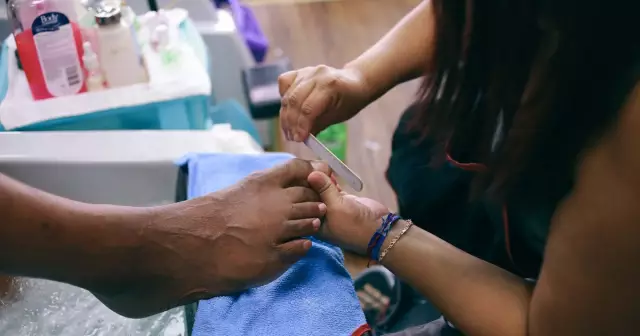- Author Rachel Wainwright [email protected].
- Public 2023-12-15 07:39.
- Last modified 2025-11-02 20:14.
6 diseases that can be contracted in a beauty salon
A beauty salon is a place that is associated exclusively with positive emotions: joy, pleasure, relaxation. However, visiting the salon is not always safe - after all, there is work with the biological material of clients. Today, more than 100 pathogenic microorganisms are known that can be infected in a beauty salon, including those that are deadly to health.
According to researchers, in Europe between 1997 and 2002, more than 2000 consumers of cosmetic services were infected with hepatitis B and about 500 with hepatitis C. According to a survey of visitors, 600 out of 1000 people received injuries with damage to the skin, one can say every second client … And microtrauma and skin cuts are a situation in which the likelihood of infection due to contact with an infected instrument is very high.
Consider 6 diseases that can be “acquired” by undergoing popular cosmetic procedures in a beauty salon.
Nail fungus
Onychomycosis (nail fungus) today affects a quarter of the world's population, every fifth person. The disease is excited by several types of microorganisms that cause damage to the nail plates, their thinning (or thickening), and discoloration. Nails begin to crumble, flake and give off an unpleasant odor. Left untreated, onychomycosis can cause nail loss and become chronic and spread to healthy nails.
The main route of infection is microcracks in the skin, formed when wearing tight shoes. People who suffer from excessive sweating of the legs, circulatory disorders, and foot deformities are especially at risk of getting infected. It is also easy to pick up nail fungus for people with stress, heavy smoking and alcohol abuse.
The pathogens are resistant to environmental influences and can remain viable for a long time. Treating the nails of a healthy person with an infected tool in almost 100% of cases will lead to the transmission of the disease.

Source: depositphotos.com
Pediculosis
This parasitic disease is a frequent visitor to hairdressing salons, which neglect sanitary standards when working with clients. The carrier of head lice is the louse - a blood-sucking insect, which can become infected during household contact. Lice eggs (nits), left on the comb, easily fall into the hair of a healthy person, where they turn into an adult and begin active reproduction.
Pediculosis is manifested by intense itching, and in advanced cases - lesions of the skin, hair follicles, inflammation of the lymph nodes in the ears and neck. In hairdressing salons, the disease is transmitted through tools (which, according to the rules, must be disinfected after each use), as well as through hair remnants cut and not removed in time.

Source: depositphotos.com
Herpes virus
The herpes virus is an infection that occurs in 90% of the world's population. The disease manifests itself in the form of periodic rashes on the lips, mucous membranes of the nose and mouth, less often in the corners of the eyes, in the groin, near the nails. Signs of the disease can be detected up to several times a month or absent altogether, depending on the state of human immunity. It should be understood that a complete cure for the herpes virus is impossible - its manifestation at any time can be triggered by an irritating factor: hypothermia (overheating), stress, lack of vitamins in the diet or PMS.
There is a risk of contracting the herpes virus during peeling, mesotherapy, permanent lip makeup and other procedures associated with even minor skin trauma. Disease prevention measures - sterilization of instruments and the use of antiseptics immediately after the session.

Source: depositphotos.com
Staphylococcus aureus
Staphylococcus aureus is a widespread bacterium in the environment that can survive outside the human body for up to 6 months. By penetrating into any tissues (skin, mucous membranes, internal organs), staphylococcus causes their inflammation, which can cause many diseases, including severe ones - for example, staphylococcal pneumonia, meningitis, endocarditis (damage to the inner lining of the heart). However, most often the infection manifests itself in the form of pyoderma - purulent skin lesions. The most common rash is in the form of boils and carbuncles with purulent contents on the back of the neck, buttocks and thighs.
Sources of infection are devices and instruments that have come into contact with foci of infection - a rash on the skin or at the base of the hair. It is easy to get the disease through ear piercing, body piercing, tattooing, and regular haircuts.

Source: depositphotos.com
Hepatitis virus
Hepatitis is a disease that has already affected more than 350 million people, and 250,000 die each year from cirrhosis of the liver. The main source of infection is blood, less often sweat, tears, feces, urine, saliva (in large volumes). Transmission of the virus can occur when mucous membranes or damaged skin come into contact with the patient's body fluids. It is worth remembering that a scanty amount of the carrier's blood is enough for infection with the virus - up to 0.0001 ml, which does not exclude the transmission of infection through infected surgical, cosmetic instruments, tattoo needles and razors.

Source: depositphotos.com
HIV infection
Through the biological fluids of a sick person, HIV infection can also occur - a potentially fatal disease that is currently not curable. The disease is accompanied by damage to the immune cells, which, having reached a critical level, leads to AIDS - acquired immunodeficiency syndrome. With its development, the body becomes unable to resist infections and can die from any of them. Unfortunately, there is a chance of contracting HIV in a beauty salon due to the negligence of its employees. The most dangerous in terms of infection are considered procedures such as tattooing, edging manicure and pedicure.

Source: depositphotos.com
Prevention of any disease from the above is ensured by disinfection of cosmetic instruments (manicure accessories, combs, needles, razors, etc.) after each use, use of disposable syringes for injections. Not only professionalism, but also cleanliness, accuracy, responsibility of a specialist should become priority qualities when choosing a beautician - so that the result of the work is not only the beauty of the body, but also its health.
YouTube video related to the article:

Maria Kulkes Medical journalist About the author
Education: First Moscow State Medical University named after I. M. Sechenov, specialty "General Medicine".
Found a mistake in the text? Select it and press Ctrl + Enter.






